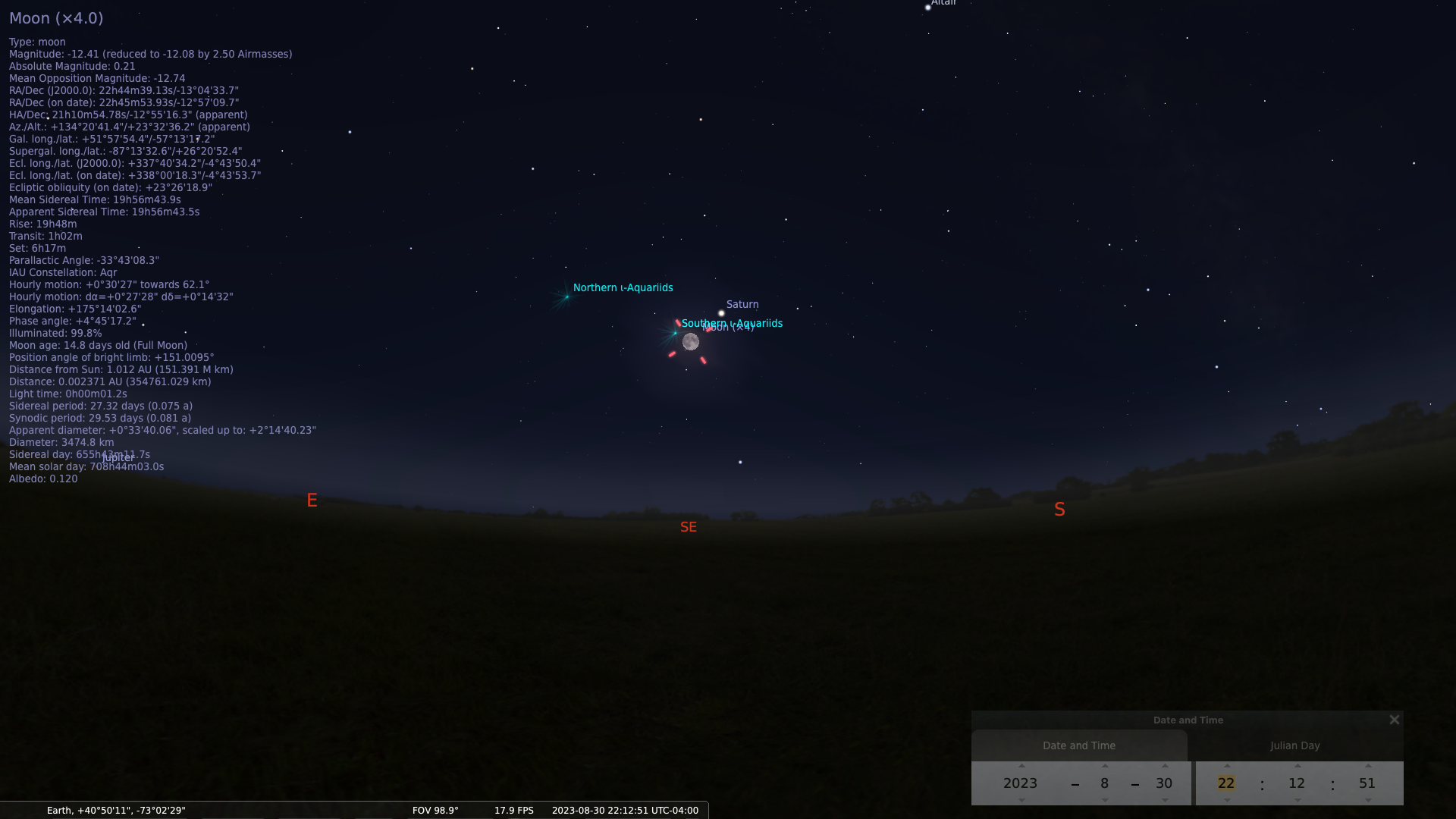
A view to the southeast on the evening of Wednesday, August 30th. The full supermoon sits low in the southeast at 10:00 PM with Saturn flanking it to the north and west. Sagittarius and the southern stars of summer are to the west and will be setting by midnight. Note the moon’s illumination of 99.8%. Image via Stellarium.
The Full Moon in August is named after North America’s largest fish, the lake sturgeon. Other names for this Full Moon include Grain Moon, Green Corn Moon, Fruit Moon, and Barley Moon.
Blue Moon
The “first” full moon for this month occurred on Tuesday, August 1st. The August 30 (Wednesday) full moon will be the second, hence, the term “blue” moon, the occurrence of more than one full moon within a calendar month.
On August 30, we will be witness to a “Blue Moon”, the last of 4 for the summer of 2023 (and the last for this year) and a Supermoon to boot! The next full blue supermoon won’t occur until August 2032, 9 years from now!
According to lore, August’s full moon is also known as a “Sturgeon Moon”. We’ve written extensively about the lore behind the moon’s names, most of which honor native traditions or coincide with seasonal events. For example, last month’s full moon (July) was the Full Buck Moon since July’s full moon occurs when bucks (male deer) are in full-growth mode. Bucks shed and regrow their antlers each year, producing a larger and more impressive set as the years progress.
August’s moon is named as such because the giant sturgeon of the Great Lakes and Lake Champlain were most readily caught during August.
Additional information on the lore of the moon and its names can be found here and here. It also should be noted that each full Moon name is applied to the entire lunar month in which it occurred, not solely to the full Moon.
Why is this month’s full moon referred to as a Supermoon, and what is a Supermoon?
Kepler’s First Law of Orbital Motion teaches us that all orbits are elliptical, some orbits more elliptical than others. This property of an ellipse, known as the eccentricity, depends, among other things, on the magnitude of the respective masses. All elliptical orbits necessarily have an apogee, the most distant point in the orbit and a perigee, the closest point in the orbit to the other orbiting body. In the case of our moon, a supermoon occurs when the moon is at its perigee point during the full-moon phase. The moon will appear ever so slightly larger simply because it’s closer. This year’s first supermoon was in May, the second was June’s Strawberry moon, July’s Full Buck Moon, the third and lastly, this month’s blue moon on August 30.

The full moon (blue highlight for effect) for June 2009 with the red supergiant star Antares to the west (left). The famous crater Tycho is to the south (up). Image courtesy, the author. Instrument: 15 cm F/4.2 astrograph.
A quick, interactive web-based version of Stellarium is available here Tonight's Sky. When you launch the application, it defaults to north-facing and your location (on mobile and desktop).
Astronomy For Change: https://astronomyforchange.org
Did you enjoy this article or like what we do? Why not leave a tip or buy us a Coffee?
Follow Us On Twitter: https://twitter.com/astronomychange
Why not support us on Patreon: https://www.patreon.com/astronomyforchange
Imagination is more important than knowledge
![]()
An index of all articles can be found here.
If you enjoyed this article, please consider supporting us with a modest donation
or through a subscription on our Patreon Page
Membership at Astronomy for Change is Free!




2 thoughts on “Super Blue Moon Coming, Biggest and Brightest of 2023”